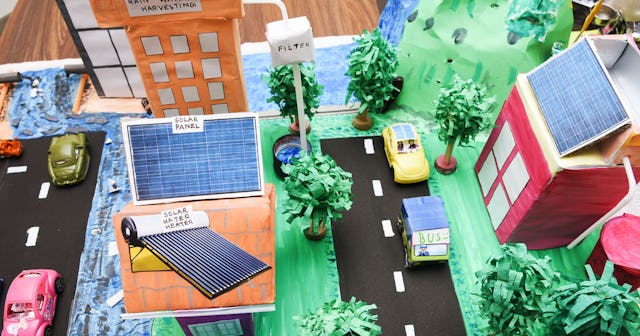Let's Be Real — Science Fairs Are For Rich Kids

I hate science fairs. I know I’m not the only one. I’ve never met another parent who doesn’t detest them – and whoever invented them.
My hatred is mostly because I end up doing the damn thing myself. Before you purists yell at me, let me say: The majority of us do our kids’ infernal science fair projects. It’s just as much a rite of parental passage as changing diapers or threatening to wash our kids’ mouths out with soap.
And it serves us right. Back in the day, when we were science fair newbies, we’d whine and moan so much that our parents would crumble and begrudgingly assemble our Newton’s cradles. We thought we’d won. But karma was taking its time, because in a few decades we would be the beaten-down dupes, coaxing a stupid-ass bean sprout through a maze while our criminally unengaged kids sit off to the side and rub Cheeto dust in their hair.
One year a science teacher sent home a letter justifying the existence of science fairs in a bulleted list. One of the perks, according to this starry-eyed fool, was being able to bond with our children, while also exploring the physical world. I think most of us would prefer to solidify parent-child relationships by hosting a family movie night or visiting Yosemite – rather than forcing a bond through a high-pressure school assignment of spurious academic value. Just a guess.
I feel sorry for myself every time the science fair comes around. I don’t want the stress, I don’t want the conflict, I don’t want to learn how to “craft my own thermos bottle and test it out for a project all about insulation.” And I certainly don’t want to shell out the cash required to participate in this soul-sucking middle school tradition.
I shouldn’t complain. We are lucky that our family can invest a small fortune in this questionable learning tool. But what about the families who are short on resources?
Some insist that there are plenty of project ideas that don’t require participants to apply for a second mortgage. However, there are problems with this argument: 1.) Students need a project that appeals to their curiosity, allows them to compete with the big dawgs, and wows the judges. What if the budget-friendly options don’t meet this criteria? 2.) Any way you cut it, that presentation board, in itself, is going to bankrupt you.
If a kid wants their display board to shine, they have to, first of all, have a display board. Science Fair Project Display Boards estimates that the typical 36”x48” board runs $6 to $14 – though I think the $6 one might be a chimera. You can buy a 25 pack for ~$80 (and you can even store them for the next multiple years your student will be forced to endure the science fair!), though a single one can run closer to $20. I think we can all agree that $6 is steep, and an Andrew Jackson is highway robbery.
No kid’s going to get away with just pasting their A4 letter-sized results and a few bright-white bold headings onto the foam board; a barebones visual would definitely signal lack of effort to the judges. Remember, also, that the culmination of the science fair project is the actual science fair, and that tri-fold board is going to be placed under fluorescent lights, on full-frontal display, for a parent-rich audience. Say a young scientist discovers a quantum-physics-based time travel machine – no one will ever know because they ignored that flimsy foam board and the flimsy paper that was dubiously adhered. Does any kid want to place last in the scholastic equivalent of the Miss America Pageant?
The science fair heavies suggest using two-sided tape (~$3), photo paper (~$8), and some neon-y cardstock (~$4) so that you can really make those pie charts “pop.” But convention dictates that our students go far above and beyond, constructing impressive multi-level boards with expertly cut headers. Scissors are not going to get the job done, so we’re talking about either investing in paper cutters (~$34) or T-bars (~$6) and Exact-o blades (~$7). Throw in some die-cut shapes (or make your own with a state-of-the-art $229 Cricut!) and unrelated-to-science-but-snazzy ornamentation (maybe even Christmas tree lights or diamond tennis bracelets!), and those boards are ready to rumble.
Of course, none of this hooplah is “necessary,” but we seasoned parents understand, intimately, what is expected. By the time that grossly elaborate board makes it to the gym floor, its price tag is definitely unreasonable and more likely absurd. And remember, we are only talking about the presentation board.
Face it: science fairs are for rich kids, and big-wig research backs my assertion. A University of Toronto study found that they “favor students from advantaged, resource-rich backgrounds,” and another study questioned whether all students had an “equal and fair chance in science fair competition” (spoiler: they did not). Honestly, we didn’t need scientific inquiry to tell us that.
So where do we go from here? In my mind, we have two options: 1.) We make resources equally available to all our students. (But what middle-schooler wants to sniff around in a communal cardboard box for a dried-up glue stick and a couple of sub-par paper punches?); or 2). We abolish the science fair altogether.
I suggest that we do every family – regardless of income – a solid. Let’s quash the time-honored but universally hated science fair once and for all. Future generations of not-going-to-be-a-scientist-anyway students and their parents will thank us.
This article was originally published on